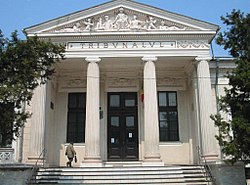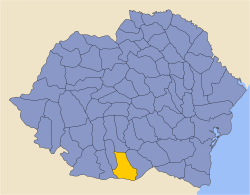Top Qs
Timeline
Chat
Perspective
Teleorman County
County of Romania From Wikipedia, the free encyclopedia
Remove ads
Teleorman County (Romanian pronunciation: [ˈtele.orman]) is a county (județ) of Romania on the border with Bulgaria, in the historical region Muntenia, with its capital city at Alexandria.
The name Teleorman is of Cumanic (Turkic) origin. It literally means wild/crazy forest (modern Turkish, Deli orman) and, by extension, "thick and shadowy forest" in the Cuman language.[3] It can be encountered in other toponyms, such as the Turkish name of the Ludogorie Plateau in northeastern Bulgaria, Deliorman.
Remove ads
Demographics
In 2021, the county had a population of 323,544 and the population density was 55.88/km2 (144.73/sq mi).
- Romanians – 87.35%[4]
- Roma – 2.92%
- Bulgarians – 0.01%
- Others – 0.06%
- Unknown – 9.66%
Remove ads
Geography
Teleorman County has a total area of 5,790 square kilometres (2,240 sq mi).
Two distinctive elements can be found:
- In the North and center there are plains from the Romanian Plain. They are separated by small rivers, which sometimes form deep valleys.
- In the South there is the Danube valley, very wide, with ponds and small channels.
Beside the Danube, the main river crossing the county is the Olt River which flows into the Danube close to the village of Islaz. Other important rivers are: the Vedea River, the Teleorman River, and the Călmățui River.
Neighbours
- Giurgiu County to the east.
- Olt County to the west.
- Argeș County and Dâmbovița County to the North.
- Bulgaria to the South – Veliko Tarnovo Province, Pleven Province, and Ruse Province.
Remove ads
Economy
The predominant industries in the county are:
- Food and beverages industry.
- Textile industry.
- Chemical industry.
- Mechanical components industry; in Alexandria there is a big roll-bearing enterprise.
Agriculture is the main occupation in the county. Both extensive agriculture, and small scale — vegetables and fruits for the Bucharest markets — is practiced. The area is well suited for irrigations.
Tourism

The county doesn't have many spectacular attractions, but its cultural folk heritage is very rich. Many Romanian personalities have been born here, some of them later describing the life in a village in a very picturesque way. Also, the area was one of the places where the Wallachian Revolution of 1848 unfolded.
The main tourist destinations are:
- The city of Alexandria.
- Fishing on the Danube and other lakes or ponds.
Remove ads
Politics
The Teleorman County Council, renewed at the 2020 local elections, consists of 32 counsellors, with the following party composition:[6]
Remove ads
Administrative divisions



Teleorman County has 3 municipalities, 2 towns and 92 communes
- Municipalities
- Alexandria - capital city; population: 42,129 (as of 2011)
- Roșiorii de Vede
- Turnu Măgurele
- Towns
- Communes
- Băbăița
- Balaci
- Beciu
- Beuca
- Blejești
- Bogdana
- Botoroaga
- Bragadiru
- Brânceni
- Bujoreni
- Bujoru
- Buzescu
- Călinești
- Călmățuiu
- Călmățuiu de Sus
- Cervenia
- Ciolănești
- Ciuperceni
- Conțești
- Cosmești
- Crângu
- Crevenicu
- Crângeni
- Didești
- Dobrotești
- Dracea
- Drăcșenei
- Drăgănești de Vede
- Drăgănești-Vlașca
- Fântânele
- Frăsinet
- Frumoasa
- Furculești
- Gălăteni
- Gratia
- Islaz
- Izvoarele
- Lisa
- Lița
- Lunca
- Măgura
- Măldăeni
- Mârzănești
- Mavrodin
- Mereni
- Moșteni
- Nanov
- Năsturelu
- Necșești
- Nenciulești
- Olteni
- Orbeasca
- Peretu
- Piatra
- Pietroșani
- Plopii-Slăvitești
- Plosca
- Poeni
- Poroschia
- Purani
- Putineiu
- Rădoiești
- Răsmirești
- Săceni
- Saelele
- Salcia
- Sârbeni
- Scrioaștea
- Scurtu Mare
- Seaca
- Segarcea-Vale
- Sfințești
- Siliștea
- Siliștea Gumești
- Slobozia Mândra
- Smârdioasa
- Stejaru
- Ștorobăneasa
- Suhaia
- Talpa
- Tătărăștii de Jos
- Tătărăștii de Sus
- Țigănești
- Traian
- Trivalea-Moșteni
- Troianul
- Uda-Clocociov
- Vârtoape
- Vedea
- Viișoara
- Vitănești
- Zâmbreasca
Remove ads
People
Natives of Teleorman County include:
Historical county
Summarize
Perspective
Historically, the county was located in the southern part of Greater Romania, in the southwestern part of the historical region of Muntenia. Its capital was Turnu Măgurele. The county was bordered on the west by the counties Romanați County and Olt County, to the north by Argeș County, to the east by Vlașca County, and in the south across the Danube River by the Kingdom of Bulgaria. Its territory coincides in large part with that of the present county.
Administration

The county was originally divided into five administrative districts (plăși):[7]
- Plasa Alexandria, headquartered at Alexandria
- Plasa Balaci, headquartered at Balaci
- Plasa Roșiori de Vede, headquartered at Roșiori de Vede
- Plasa Turnu Măgurele, headquartered at Turnu Măgurele
- Plasa Zimnicea, headquartered at Zimnicea
Subsequently, the county established three more districts:
- Plasa Călmățuiu, headquartered at Călmățuiu
- Plasa Slăvești, headquartered at Slăvești
- Plasa Vârtoapele de Sus, headquartered at Vârtoapele de Sus
The county contained four urban communes: Turnu Măgurele, Alexandria, Roșiorii de Vede, and Zimnicea.
Population
According to the 1930 census data, the county population was 347,294 inhabitants, ethnically divided as follows: 98.1% Romanians, 1.4% Romanies, as well as other minorities. From the religious point of view, the population was 99.0% Eastern Orthodox, 0.6% Adventist, 0.1% Muslim, as well as other minorities.
Urban population
In 1930, the county's urban population was 58,632 inhabitants, comprising 94.4% Romanians, 3.3% Romanies, 0.4% Hungarians, 0.4% Jews, as well as other minorities. From the religious point of view, the urban population was composed of 98.1% Eastern Orthodox, 0.6% Muslim, 0.4% Jewish, 0.4% Roman Catholic, as well as other minorities.
Remove ads
References
External links
Wikiwand - on
Seamless Wikipedia browsing. On steroids.
Remove ads






